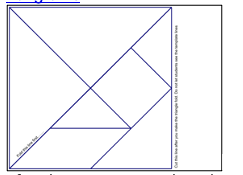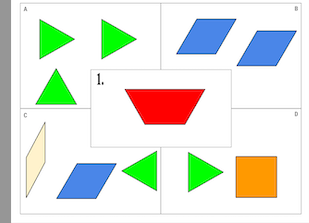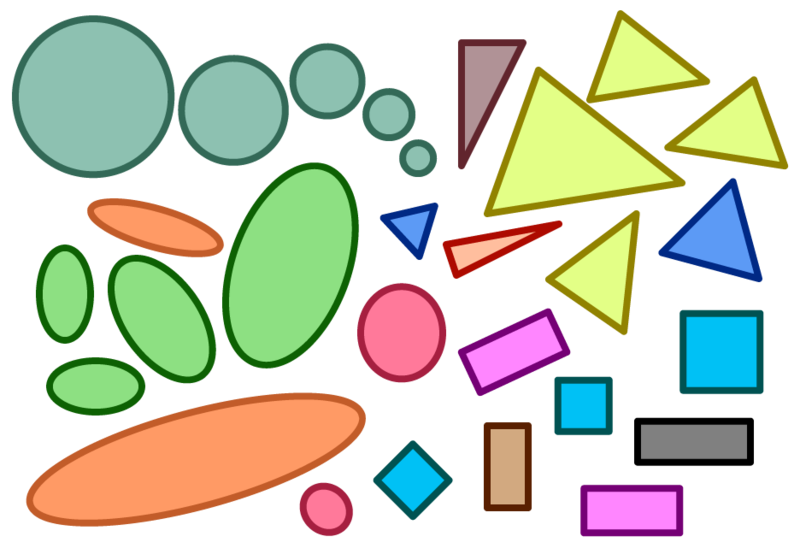Summary
Like building blocks, tangrams and pattern blocks can teach kids about spatial relationships and help them develop problem-solving skills. Students will explore many ways to compose and decompose shapes using pattern blocks and tangrams in this lesson. Students will also acquire an understanding and use geometric vocabulary to describe the attributes of the shapes to others. Finally, students will read and write about shapes and then use them as their illustration tools.
Essential Question(s)
How do we use two-dimensional shapes (rectangles, squares, trapezoids, rhombi, and triangles), to create a composite shape? How can I compose a new shape from a composite shape? How can I decompose a composite shape?
Snapshot
Engage
Students each build something with pattern blocks. Students then share with an Elbow Partner and do a Gallery Walk to view the creations of their classmates.
Explore
Students sort shape cards in numerous ways and explain their thinking to the class. Then, they sort and match by shapes and check their work by using a set of tangrams.
Explain
Using the book "A Sage's Journey: The Story of Tangrams,", students see decomposing and composing shapes modeled. At this time, the formal vocabulary is introduced and discussed. After the story, students compose and decompose their own set of tangrams.
Extend
As a class, students create a pattern block or tangram story.
Evaluate
Student detectives participate in a Shape Scoot, detecting the correct decomposition or composition of the figures in each shape puzzle.
Materials
Shape Sorting Cards (attached; one per group)
Paper Tangrams (attached)
Shape Scoot Mats (attached)
Shape Scoot recording sheet (attached; one per student)
Shape Scoot answer key (attached)
Word Wall cards (attached)
Pattern blocks (one set per student)
Containers for each group’s Pattern blocks
Sticky Notes
Tangrams
Pencils
Card Sort
Engage
20 Minute(s)
Give each table group a container with a variety of pattern blocks. Instruct students to build something independently with the pattern blocks.
Have students look at an Elbow Partner’s creation and write something they noticed on a sticky note. Share a few of these ideas with the whole class.
Next, give students four more stickies and have them do a Gallery Walk to look at other classmates’ creations. Finally, assign or have students choose 3-4 of the designs to write something they noticed or a question about the builds.
When students return to their table groups, they should share with their group what was written on their creations’ stickies.
Students take their builds apart and create something new. Talk to students about how they put the blocks together to make new shapes and designs. Have them talk to each other about the number and kinds of shapes they used.
Explore
20 Minute(s)
Group students in groups of 4. Give each group a set of the Shape Sorting Cards for the Card Sort activity.
Start by asking students to sort their cards any way they want. Do not lead or prompt the students other than to sort the cards.
Call on volunteers to explain how they sorted their cards. They will likely sort their cards into many or single shapes. Color is not a choice since the cards are black and white.
Now have the students sort again, but this time they should work together to match cards with many shapes to a card with one shape. At this time, give each group two sets of classroom tangrams to test their work.
Explain
40 Minute(s)
As you work through this demonstration, use the vocabulary word wall words and place them on the board as you use and explain the words with your students.
Hold up the template of the tangram that is blank on one side. (See diagram below).
Fold a triangle on one end and cut off the remaining piece. This piece gives you a rectangle. Ask a volunteer to identify the shape and state its attributes. Set the rectangle aside.
Ask a different volunteer to describe the piece you are still holding.
Continue cutting the paper, starting with the large triangle fold just made. As you make these cuts, explain to the students that you are decomposing the sheet of paper. With each cut, the paper gets smaller and smaller.
After all the cuts are made, introduce the story, "A Sage's Journey: The Story of Tangrams" This is a link to an online version of A Sage's Journey: The Story of Tangrams.
After the story, give each student a paper tangram template to decompose their tangrams and compose a square from the composite pieces. Remind them to discard the rectangle.

Extend
In this part of the lesson. students create a pattern block or tangram story. First, students complete one page of the story by composing pictures with pre-cut construction paper shapes and gluing them onto plain white paper. Next, students use crayons, markers, and pencils to add detail to their pictures. After students complete their pictures, they should write a story about their pictures.
Bind the pages together to create a book or upload the pictures into Google Slides, Seesaw, or another online platform. Consider recording yourself or students reading their class book aloud. Don’t forget to share with parents and other classes.
Here are two examples of class books about shapes: DeeDee the Square: A Tangram Story and Tangram Stories.
Evaluate
The students become "Shape Detectives" by doing a Shape Scoot where they detect the correct decomposition or composition of the figures in each shape puzzle.
Set out the attached Shape Scoot Mats and sets of pattern blocks. The mats are numbered to correspond with a Shape Scoot Recording Sheet. Ensure each student gets one. Student Detectives move from shape to shape, solving each shape puzzle and recording their answers. If you do not use all of the mats, mark out the corresponding boxes on the answer sheet before running them off.
It may take two sessions to complete the Shape Scoot.
Example Shape Scoot Mat: (attached as a handout)

Opportunities for Gifted Learners
Students create a collaborative story by composing and decomposing shapes to create a story. The story should include the story elements, setting, characters, problem, and solution. Students can use Seesaw or another digital tool to narrate or video record their stories.
Resources
K20 Center. (n.d.). Gallery walk/carousel. Strategies. https://learn.k20center.ou.edu/strategy/118
K20 Center. (n.d.). Card sort. Strategies. https://learn.k20center.ou.edu/strategy/147
K20 Center. (n.d.). Elbow partners. Strategies. https://learn.k20center.ou.edu/strategy/116
K20 Center. (n.d.). Scoot. Strategies. https://learn.k20center.ou.edu/strategy/2298
K20 Center. (n.d.). Seesaw. Tech Tools. https://learn.k20center.ou.edu/tech-tool/671
Mathverick. (March 8, 2010). The Sage’s Story: A Tangram Story. https://www.youtube.com/watch?v=X5mc-dkYLfI&t=8s
Mrs. Greiling's Classroom. (December 1, 2014). Dee Dee The Square a Tangram Story. YouTube. https://www.youtube.com/watch?v=cQd9FBa6Lwc
Tech4Learning. (January 5, 2021). Tangram Stories. https://youtu.be/07UcYr2l1mI


